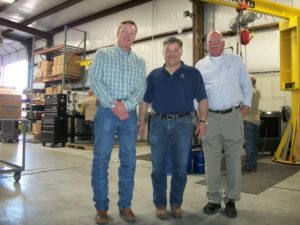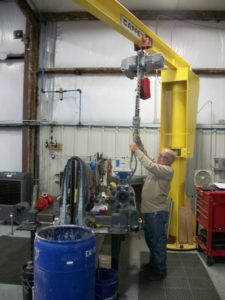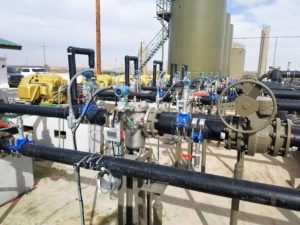By Paul Wiseman
To be a Basin business and be a mere four years old and have almost 100 employees—this is not the typical track for a Permian startup of recent vintage. But at Van Zandt Controls, Larry Richards and team have focused small to grow big.
The news is always full of stories of mergers and acquisitions as every sector—upstream, midstream, producers, service companies, and all—try to stay afloat by getting bigger and bigger.
So it’s conversely newsworthy when a company like Van Zandt Controls decides to grow bigger by laser-focusing on just a few products—and succeeds wildly in the process.
In 2015—a bust-time in which only a few brave souls would dream of spearheading a startup—Lance Van Zandt knew he had developed a marketable product line, one that a narrowly-defined client base would eagerly receive, so he decided to go for it. He opened Van Zandt Controls that year, with customers primarily in upstream and midstream sectors, but with a small reach into downstream applications.
Things started well enough that industry veterans Larry Richards and Dave Latch, who had previously grown Hy-Bon into the top firm it is today, saw the potential in Van Zandt Controls and wanted to join forces. Backed by Houston-based OFS Energy Fund, they bought in. Since then company growth has exploded.
When they came along, Richards and Latch were numbers seven and eight on the payroll. In June of this year the company hired employee number 98, across seven locations including the home office east of Odessa.
Richards is one of those with a long and deep oilfield heritage. There may be more West Texas Intermediate in his veins than blood. “My dad worked for Getty Oil for 30-plus years,” he said. “I mainly grew up in South Louisiana, but we moved quite a bit over the years—always somewhere there was a pump jack. I lived in Andrews and throughout Texas and Louisiana, and graduated from high school in Houston.”
Richards earned a business management degree from Texas A&M. After an initial job outside the oil and gas industry, he took a job with Continental EMSCO, helping the drilling rig manufacturer integrate into Mexico and South America.
He climbed the ladder with EMSCO, becoming vice president of operations, vice president of marketing and sales, and, eventually, chief operating officer of the company’s well servicing unit. When National Oilwell acquired EMSCO, Richards went to Key Energy Services as a vice president.
Richards joined Hy-Bon as president in 2003, and was promoted to CEO in 2008, leading the company to exponential growth. It was that pedigree he brought to Van Zandt.
From the start, Lance Van Zandt had helped several companies innovate and design wellhead automation systems for emergency shutdown valves (ESDs). There were also gas lift, salt water disposal (SWD), and tank valve applications for his systems.
His biggest step was in gaining the respect of midstream companies, who standardized the use of Van Zandt automated valve applications for pipes 18 inches in diameter and below.
Richards was impressed when he met Van Zandt and saw the company’s growth to that point. “I was just amazed, when I first met him, that a company of this size in 2015 and ’16 was being added to the vendor list of all these major oil companies, to their MSA (master service agreement) lists,” he said. “They weren’t adding anyone” during that time.
Shortly after Richards and Latch joined the company, Jeff Wesson left a 25-year career at Rawson LP (another valve, control, and instrumentation firm) to be added to the mix.
Many have asked Richards the secret to the company’s rapid growth. In answer to that, he lists two basic elements.
“One is, we honor God and we try to handle all aspects of our business with integrity,” he said. He added that, while growth is important, growing it the right way is even more important. After 20 years in the Permian Basin, Richards said he’d learned that honesty and integrity are instrumental in growing a business in the area.
“Number two is that we put safety first, period.” On their path to almost 100 employees, Richards said there has only been one OSHA-reportable incident in four years, and no lost-time accidents. “We are hyper-focused on the safety of our employees,” he added.
Another growth-factor ingredient has been a laser focus on three main areas, plus the purchase of a company that makes hard-to-get brackets, couplers, and spools.
“We only do three things,” he said. “We do automated valves, we do flow meters, and we do instrumentation—targeted to the instrumentation that goes with the valve, automation, or flow project.
“By targeting that niche, you can be extremely competent in a small range of products—and in that niche we’ll go toe-to-toe with anybody in the world.”
The company’s operating philosophy was based on extensive face-to-face customer research, yielding three key elements.
“We got a real consistent message back,” Richards recalled. “They said, number one, we need you to be able to understand the technical field applications that we’re putting this equipment in.” That would allow Van Zandt personnel to quickly and accurately quote the best solution, with multiple options for the client to choose from.
“Number two, which was kind of interesting to me, they said, ‘Give us a delivery commitment and hit it. If you will do that one thing, you’ll so differentiate yourself from your competition, that you’ll gain a huge part of our business.’”
 Focusing energy and resources on that, said Richards, the company reached a 97 percent on-time delivery rate in May.
Focusing energy and resources on that, said Richards, the company reached a 97 percent on-time delivery rate in May.
“Number three was that we had to back it up with fast, reliable service in the field.” No matter how reliable and well-designed the equipment, they told him, if service can’t be accomplished within a couple of hours, “then it’s not going to do us a lot of good.”
Among the company’s biggest developments: automated wellhead ESDs, automated gas lift valves, and ultrasonic water flow meters for produced and fresh water.
Wellhead ESDs traditionally consisted of gate valves, whose rectangular nature often allowed debris to build up across the lip at the bottom, where the gate descends to in closing. If sand or other debris is there, the gate can’t close, allowing some amount of liquid to continue to pass through. With “emergency” being the operative word in “emergency shutdown valve,” it’s easy to see why this is a problem.
Before horizontal wells with multiple fracs, gate valves had less sand and debris to contend with. Given the length and complexity of today’s wells, Van Zandt saw the need for a new valve design.
Another issue is that the gate valve used a pneumatic actuation powered by casing head gas. “Casing head gas is really wet—it’s high BTU gas,” said Richards, “so those little tubing lines fill with liquid from water vapor or condensate. In the winter, that liquid freezes,” which also causes the valve not to close.
The solution? “We helped pioneer the use of a really high pressure, low-torque ball valve in that application,” he said, noting that the design originated in offshore installations.
The ball valve eliminates clogging and, because the actuator is electric, it does away with the freezing issues inherent in the pneumatic valves. There is also less maintenance because it does not collect sand and debris.
Another new product was an ultrasonic flow meter for produced and fresh water. Instead of being installed inside the pipe, this meter straps onto the outside of the pipe. Richards said they can be calibrated for oil measurement as well, “but the overwhelming majority that we’re putting out in the field are for all the produced water and fresh water that’s moving from location to location.”
The meter measures flow within one percent of the accuracy of a custody transfer meter. It’s inexpensive and it straps onto the outside of steel or poly pipe. There is no need to cut into any pipe or shut off the flow during installation. External installation also means it never clogs or needs to be cleaned.
Moving forward, Richards sees the next growth area in what he calls “kitting solutions.” In other words, “We will kit all the automated valves, flow meters, and the instrumentation for a project. We can help them standardize all those components for a new tank battery. Then it’s a matter of replicating that solution, tank battery by tank battery.” The components are shrink-wrapped onto a pallet (or several pallets for a larger installation), which is shipped out to the location as a whole.
Another area of focus is working with customers in the planning stages of an installation, due to some long lead times required by some manufacturers of actuators and other instrumentation. “We’ve been able to control our destiny on our delivery by building inventory,” which allows them the 97 percent on-time delivery rate previously mentioned. “We can control our own delivery commitments by having the equipment in stock,” he said.
For components Van Zandt doesn’t stock, the lead time can be 20-30 weeks. So being part of the up-front planning efforts allows Van Zandt to pre-order those items to get delivery in time for schedules to be met.
Richards is pleased that the company’s main location out of seven is in Odessa, where oil and gas are the main focus of most businesses. That also allows them to hire engineering students from UTPB, although he said they’ve also hired from as far away as Purdue.
Paul Wiseman is a freelance writer in Midland.










